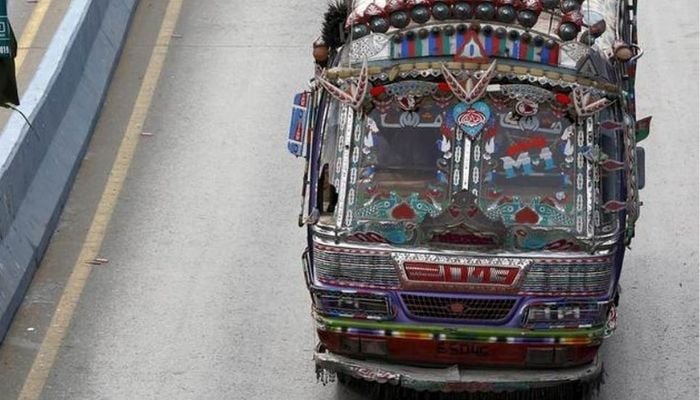The upside to rise in oil prices
The unprecedented increase in fuel prices has forced some people to move away from private vehicles and switch to public transport
July 07, 2022

It seems to be working. The unprecedented increase in fuel prices has forced some people to move away from private vehicles and switch to public transport, especially in cities like Lahore and Islamabad where multiple transit lines are currently operational. Karachi is scrambling to fully operationalise the People’s Bus Service. By all means, this is a good thing.
Our energy crisis is a crisis of built form. We have to re-build out of it – only this time, do it differently, and do it better.
The first step to re-building better has to be acknowledging the harms brought by how we’ve built for decades. Our cities are concrete jungles. Roads that pass through dense commercial areas have three, four, even six or more lanes on each side. Green spaces have disappeared into new plots. There is no road with safe passage for motorized two-wheelers, let alone for cyclists. Many recent urban developments do not even have sidewalks for pedestrians along main roads. Where sidewalks exist, they are erratically planned and poorly built. Old drainage channels that helped carry flood water now have homes, plazas, and mosques built on them.
In short, our cities have successfully excluded most of both people and nature from them.
The second step has to be undoing some of our most pathetic choices. Dismantle signal free urban corridors. Remove one, two, even three lanes from most urban corridors. Take down all roads, houses, plazas, mosques, concrete linings, and other structures built on streams, rivers, and other seasonal or perennial drainage channels.
This is a question of political will. No political government wants to be known for reducing road widths, just like no party wanted to be known for jacking up fuel and energy prices. Everybody wants to be known for widening roads and building new ones. Parties want to be known for announcing unfunded, regressive subsidies on fuel that drive the country straight to disaster. Even private housing societies want to be known for their eight-lane boulevards that run through the middle of their commercial areas.
The outcomes are, frankly, ridiculous. The urban heat island effect is at unbelievable levels in our cities, and we continue to make it worse by removing green areas and needlessly paving even more natural surfaces. Bus routes are nonexistent for the most part – where there’s a nearby route, it is nearly impossible to safely walk to the nearest bus stop. Walking or cycling is a terrible experience due to unfriendly roads and a lack of shade. The political positioning of mass transit and related projects is the cherry on top: for decades, we have marketed transit and related projects to be for the “poor” people.
This makes it particularly hard for people in the middle class to reconcile with the latest challenge of high fuel prices. Have they been rendered so poor that they must now take the bus to work?
It is not fair to force people to suddenly change habits when the entire built and social environment is stacked against them. Rising fuel prices have forced some people to take the bus already, but transit remains a socially or physically difficult choice for many others.
This is a golden opportunity to make tough political and planning decisions. Wide roads are inherently unsafe for pedestrians and two-wheelers and therefore discourage use of public transport: let all urban roads be limited to two lanes in each direction, with one of those reserved for buses and other forms of public transport. High-speed traffic discourages commercial activity, limits the efficacy of public transport, and literally kills dozens of people every year: let the speed limit in all urban areas be less than 35km/h, with physical interventions like narrow lanes and speed breakers for enforcement.
Obscene overhead pedestrian crossings that require climbing stairs or ramps are toxic for downtown commercial activity and useful only for very few, physically fit individuals: let all pedestrians cross all urban roads at grade, with signalized crossings that bring traffic to a halt if needed.
Car users do not pay for the full social cost of their usage despite historic fuel prices. The true social cost of private car use would include things like environmental damage resulting from road construction and emissions; declining public health due to emissions, lead exposure, and stress; forex implications of importing oil; surface runoff and urban flooding caused by paved roads and concretization; commercial losses that occur because of wide expressways that slice through dense commercial areas; construction and maintenance costs of these obscene roads; displacements caused by land acquisition for road widening; lost economic opportunities due to prime space allocated to roads, parking lots, and other car-related infrastructure; lives lost to accidents; costs of maintaining massive traffic police departments; and countless other factors. Yet our calculus remains focused on the cost of fuel at the pump.
There are two ways to fix this calculus. Charge car users for the true social cost of their choices, and concurrently reduce the social costs incurred to facilitate them. Our ongoing crisis is the opportunity of a lifetime to re-build forward – with more clarity, equity, and justice than ever before.
The writer is a PhD candidate at the University of Illinois at Urbana-Champaign.
He tweets @faizaanq and can be reached at: [email protected]











